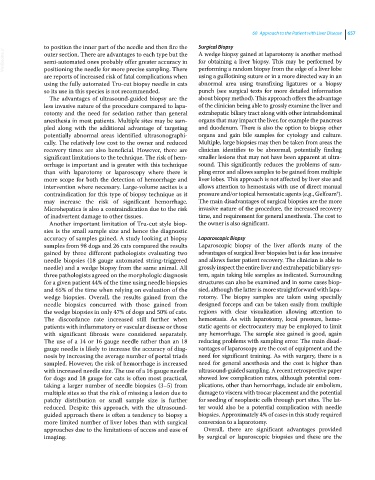Page 689 - Clinical Small Animal Internal Medicine
P. 689
60 Approach to the Patient with Liver Disease 657
to position the inner part of the needle and then fire the Surgical Biopsy
VetBooks.ir outer section. There are advantages to each type but the for obtaining a liver biopsy. This may be performed by
A wedge biopsy gained at laparotomy is another method
semi-automated ones probably offer greater accuracy in
performing a random biopsy from the edge of a liver lobe
positioning the needle for more precise sampling. There
are reports of increased risk of fatal complications when using a guillotining suture or in a more directed way in an
using the fully automated Tru‐cut biopsy needle in cats abnormal area using transfixing ligatures or a biopsy
so its use in this species is not recommended. punch (see surgical texts for more detailed information
The advantages of ultrasound‐guided biopsy are the about biopsy method). This approach offers the advantage
less invasive nature of the procedure compared to lapa- of the clinician being able to grossly examine the liver and
rotomy and the need for sedation rather than general extrahepatic biliary tract along with other intraabdominal
anesthesia in most patients. Multiple sites may be sam- organs that may impact the liver, for example the pancreas
pled along with the additional advantage of targeting and duodenum. There is also the option to biopsy other
potentially abnormal areas identified ultrasonographi- organs and gain bile samples for cytology and culture.
cally. The relatively low cost to the owner and reduced Multiple, large biopsies may then be taken from areas the
recovery times are also beneficial. However, there are clinician identifies to be abnormal, potentially finding
significant limitations to the technique. The risk of hem- smaller lesions that may not have been apparent at ultra-
orrhage is important and is greater with this technique sound. This significantly reduces the problems of sam-
than with laparotomy or laparoscopy where there is pling error and allows samples to be gained from multiple
more scope for both the detection of hemorrhage and liver lobes. This approach is not affected by liver size and
intervention where necessary. Large‐volume ascites is a allows attention to hemostasis with use of direct manual
contraindication for this type of biopsy technique as it pressure and/or topical hemostatic agents (e.g., Gelfoam®).
may increase the risk of significant hemorrhage. The main disadvantages of surgical biopsies are the more
Microhepatica is also a contraindication due to the risk invasive nature of the procedure, the increased recovery
of inadvertent damage to other tissues. time, and requirement for general anesthesia. The cost to
Another important limitation of Tru‐cut style biop- the owner is also significant.
sies is the small sample size and hence the diagnostic
accuracy of samples gained. A study looking at biopsy Laparoscopic Biopsy
samples from 98 dogs and 26 cats compared the results Laparoscopic biopsy of the liver affords many of the
gained by three different pathologists evaluating two advantages of surgical liver biopsies but is far less invasive
needle biopsies (18 gauge automated string‐triggered and allows faster patient recovery. The clinician is able to
needle) and a wedge biopsy from the same animal. All grossly inspect the entire liver and extrahepatic biliary sys-
three pathologists agreed on the morphologic diagnosis tem, again taking bile samples as indicated. Surrounding
for a given patient 44% of the time using needle biopsies structures can also be examined and in some cases biop-
and 65% of the time when relying on evaluation of the sied, although the latter is more straightforward with lapa-
wedge biopsies. Overall, the results gained from the rotomy. The biopsy samples are taken using specially
needle biopsies concurred with those gained from designed forceps and can be taken easily from multiple
the wedge biopsies in only 47% of dogs and 50% of cats. regions with clear visualization allowing attention to
The discordance rate increased still further when hemostasis. As with laparotomy, local pressure, hemo-
patients with inflammatory or vascular disease or those static agents or electrocautery may be employed to limit
with significant fibrosis were considered separately. any hemorrhage. The sample size gained is good, again
The use of a 14 or 16 gauge needle rather than an 18 reducing problems with sampling error. The main disad-
gauge needle is likely to increase the accuracy of diag- vantages of laparoscopy are the cost of equipment and the
nosis by increasing the average number of portal triads need for significant training. As with surgery, there is a
sampled. However, the risk of hemorrhage is increased need for general anesthesia and the cost is higher than
with increased needle size. The use of a 16 gauge needle ultrasound‐guided sampling. A recent retrospective paper
for dogs and 18 gauge for cats is often most practical, showed low complication rates, although potential com-
taking a larger number of needle biopsies (3–5) from plications, other than hemorrhage, include air embolism,
multiple sites so that the risk of missing a lesion due to damage to viscera with trocar placement and the potential
patchy distribution or small sample size is further for seeding of neoplastic cells through port sites. The lat-
reduced. Despite this approach, with the ultrasound‐ ter would also be a potential complication with needle
guided approach there is often a tendency to biopsy a biopsies. Approximately 4% of cases in this study required
more limited number of liver lobes than with surgical conversion to a laparotomy.
approaches due to the limitations of access and ease of Overall, there are significant advantages provided
imaging. by surgical or laparoscopic biopsies and these are the

